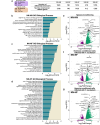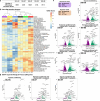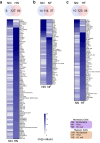Fusobacterium nucleatum infection modulates the transcriptome and epigenome of HCT116 colorectal cancer cells in an oxygen-dependent manner
- PMID: 38720110
- PMCID: PMC11079022
- DOI: 10.1038/s42003-024-06201-w
Fusobacterium nucleatum infection modulates the transcriptome and epigenome of HCT116 colorectal cancer cells in an oxygen-dependent manner
Abstract
Fusobacterium nucleatum, a gram-negative oral bacterium, has been consistently validated as a strong contributor to the progression of several types of cancer, including colorectal (CRC) and pancreatic cancer. While previous in vitro studies have shown that intracellular F. nucleatum enhances malignant phenotypes such as cell migration, the dependence of this regulation on features of the tumor microenvironment (TME) such as oxygen levels are wholly uncharacterized. Here we examine the influence of hypoxia in facilitating F. nucleatum invasion and its effects on host responses focusing on changes in the global epigenome and transcriptome. Using a multiomic approach, we analyze epigenomic alterations of H3K27ac and global transcriptomic alterations sustained within a hypoxia and normoxia conditioned CRC cell line HCT116 at 24 h following initial infection with F. nucleatum. Our findings reveal that intracellular F. nucleatum activates signaling pathways and biological processes in host cells similar to those induced upon hypoxia conditioning in the absence of infection. Furthermore, we show that a hypoxic TME favors F. nucleatum invasion and persistence and therefore infection under hypoxia may amplify malignant transformation by exacerbating the effects induced by hypoxia alone. These results motivate future studies to investigate host-microbe interactions in tumor tissue relevant conditions that more accurately define parameters for targeted cancer therapies.
© 2024. The Author(s).
Conflict of interest statement
The authors declare no competing interests.
Figures






Similar articles
-
Modulation of the Host Cell Transcriptome and Epigenome by Fusobacterium nucleatum.mBio. 2021 Oct 26;12(5):e0206221. doi: 10.1128/mBio.02062-21. Epub 2021 Oct 26. mBio. 2021. PMID: 34700376 Free PMC article.
-
Association of Fusobacterium nucleatum with immunity and molecular alterations in colorectal cancer.World J Gastroenterol. 2016 Jan 14;22(2):557-66. doi: 10.3748/wjg.v22.i2.557. World J Gastroenterol. 2016. PMID: 26811607 Free PMC article. Review.
-
Fusobacterium nucleatum host-cell binding and invasion induces IL-8 and CXCL1 secretion that drives colorectal cancer cell migration.Sci Signal. 2020 Jul 21;13(641):eaba9157. doi: 10.1126/scisignal.aba9157. Sci Signal. 2020. PMID: 32694172 Free PMC article.
-
Fusobacterium nucleatum induces oxaliplatin resistance by inhibiting ferroptosis through E-cadherin/β-catenin/GPX4 axis in colorectal cancer.Free Radic Biol Med. 2024 Aug 1;220:125-138. doi: 10.1016/j.freeradbiomed.2024.04.226. Epub 2024 Apr 22. Free Radic Biol Med. 2024. PMID: 38657754
-
Fusobacterium nucleatum modulates the Wnt/β-catenin pathway in colorectal cancer development.Int J Biol Macromol. 2025 Apr;299:140196. doi: 10.1016/j.ijbiomac.2025.140196. Epub 2025 Jan 21. Int J Biol Macromol. 2025. PMID: 39848378 Review.
Cited by
-
Oxidative Stress by H2O2 as a Potential Inductor in the Switch from Commensal to Pathogen in Oncogenic Bacterium Fusobacterium nucleatum.Antioxidants (Basel). 2025 Mar 7;14(3):323. doi: 10.3390/antiox14030323. Antioxidants (Basel). 2025. PMID: 40227274 Free PMC article.
-
The gut microbiota in cancer immunity and immunotherapy.Cell Mol Immunol. 2025 Sep;22(9):1012-1031. doi: 10.1038/s41423-025-01326-2. Epub 2025 Aug 6. Cell Mol Immunol. 2025. PMID: 40770084 Free PMC article. Review.
-
Oral Health and Caries Prevention: How Tongue Hygiene Helps Maintain Balance of Microbiota and Overall Health in Pediatric Patients.Children (Basel). 2024 Jul 3;11(7):816. doi: 10.3390/children11070816. Children (Basel). 2024. PMID: 39062265 Free PMC article. Review.
-
Stool and blood biomarkers for colorectal cancer management: an update on screening and disease monitoring.Mol Cancer. 2024 Nov 19;23(1):259. doi: 10.1186/s12943-024-02174-w. Mol Cancer. 2024. PMID: 39558327 Free PMC article. Review.
-
HIF1A, EPAS1, and VEGFA: angiogenesis and hypoxia-related gene expression in endometrium and endometrial epithelial tumors.J Appl Genet. 2025 Jan 31. doi: 10.1007/s13353-025-00939-7. Online ahead of print. J Appl Genet. 2025. PMID: 39888575
References
-
- Hanahan D. Hallmarks of cancer: new dimensions. Cancer Discov. 2022;12:31–46. doi: 10.1158/2159-8290.CD-21-1059. - DOI - PubMed
Publication types
MeSH terms
Substances
Grants and funding
LinkOut - more resources
Full Text Sources
Medical

